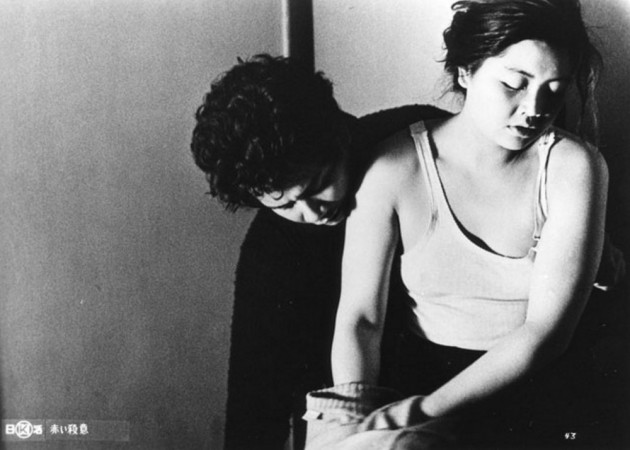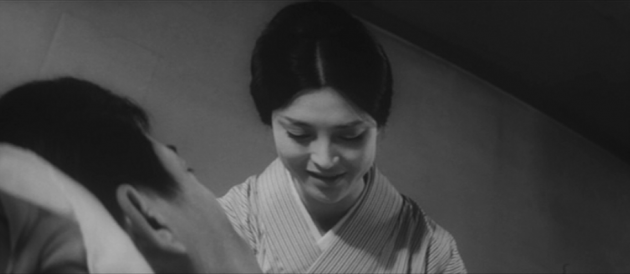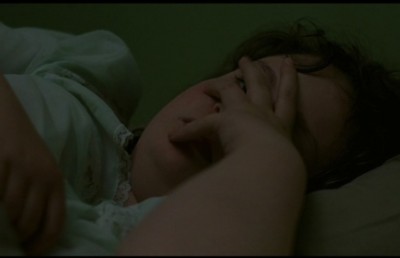Mapping the Social: The Bedroom in the Japanese New Wave

The Japanese New Wave came about at a particularly eventful time for Japan. 1960 saw the ratification of ANPO (The Treaty of Mutual Cooperation and Security between the United States and Japan) create widespread protests led by a younger generation who had lived through the nationalism of WWII and the wealth and American influence of the Japanese post-war economic miracle. 1960 also saw a new generation of brash young directors who rejected the top-down structures of the Japanese studio system and created idiosyncratic, socially-conscious and formally daring works that challenged the paradigms of Japanese society. One of the ways these artists achieved this is by repositioning the bedroom, a space that had become a symbol of the family, one of the central institutions of Japanese society, and turning it into a metaphorical battleground between generations, genders and social groups. In effect, those filmmakers used the space of the bedroom to comment on and stage the struggles that shook Japanese society at large as well as to directly involve the audience in the meaning-making of the image. André Bazin’s theories surrounding film space and its potential ambiguity provide the basis for a sustained look at the use of space as social agent in the films of the Japanese New Wave, and an interrogation of the films of Yasujiro Ozu, Shohei Imamura and Yoshishige Yoshida.
To begin, it is important to situate the bedroom in its Japanese context. As in most cultures, the bedroom serves as a space where the parents, the bearers and keepers of the nuclear family, interact and live. However, in many Japanese households the bedroom also serves the purpose of a communal family room. The mattresses used to sleep on are put away and the room becomes a sort of living room for everyday use. This further reinforces the notion of the parental bedroom as the centre of family life, its function extending beyond a purely marital space to absorb all of the activities of the family. This distinction is vital, because the films of the Japanese New Wave were distinctly pitching themselves to a Japanese audience. They engaged with Japanese society, the political situation and Japanese cinematic history to create a direct link with the Japanese public. It is therefore no surprise that those films would use a space as loaded with meanings for Japanese people and with such ties to as central a part of Japanese society as the family unit as a metaphor for the country’s ever-changing social and political landscape.
New Wave filmmakers weren’t the first to view the bedroom as fertile ground for drama and social commentary. Yasujiro Ozu and Mikio Naruse both centred their family dramas in and around the bedroom. and subtly chronicled the rapid changes Japanese society was undergoing in the post-war period. For example, much of the action in Tokyo Story (Yasujiro Ozu, 1953) takes place in bedrooms, with the elderly couple at the centre of the story occupying those spaces as they are shuffled from one apartment to the other. Ozu, with his gentle classicism, filming them at “tatami” level in long takes and oftentimes through doorways to fully capture the space and create critical distance, expresses the clash of generations by juxtaposing the traditional bodies of the couple (they are always dressed in traditional garb) against the modern living spaces of their children.
However, what sets the New Wave generation apart is its willingness to question and upend the status quo both politically and formally. Taking as emblematic the cinema of Shohei Imamura, a former assistant director to Ozu who loudly declared his hatred of the master’s films, the differences between the two generations and their handling of the bedroom becomes apparent. In Intentions of Murder (Shohei Imamura, 1964), Imamura chronicles the travails of a lower-class married woman who is raped and romantically pursued by a thief. The differences announce themselves quickly. Contrary to Ozu, who typically set his stories among middle-class families, Imamura chooses the poor and the downtrodden as his focus. The family bedrooms in particular reveal this disparity. In Late Spring (Yasujiro Ozu, 1949), the bedroom is tastefully decorated and immaculately clean in a nice two storey house. The bedroom in Intentions of Murder is dilapidated and squalid, situated in a house in ruins next to train tracks. The difference in circumstances, exemplified by the bedrooms, reflects the disparity in approaches between the two generations. Ozu is content to focus on the middle-class and its struggles, limiting his gaze to the better part of society and their relatively benign problems (Late Spring centres on a daughter not wanting to get married to stay with her father). Imamura digs deeper, showing the people who were forgotten by the economic miracle, both contradicting the established narrative of Japan as a developed, problem-free country and diagnosing the woes of the nation from its marginalized groups. This is not subtle chronicle but acerbic critique showing people whom society would prefer to forget.
The films of the New Wave do more than simply present an under-exposed reality through their use of space. André Bazin believed in the capacity of the image to capture the ambiguity of life. To him, depth of field brought “the spectator into a relation with the image closer to that which he enjoys with reality” (35). The space which the image captures in its ambiguity brings the viewer deeper into the meaning-making of the film. Bazin continues that “It is from his attention and his will that the meaning of the image in part derives” (36). The New Wave filmmakers understood this dynamic between the viewer and the ambiguous image. They injected meaning into the spaces of everyday life, such as the bedroom or the street, and highlighted the clashes those zones contained, pushing the viewer to question and revisit them with fresh eyes.

Subversive sex in Intentions of Murder
Intentions of Murder exposes the oppression and violence that Japanese society imposes on women. Japan is a patriarchal society and one of the basic metaphors that held it together during the Meiji period and all the way through WWII was the idea of the Emperor as benevolent father to the Japanese nation. Japan, in a way, understood itself as a family and society, from the top to the bottom, and functioned around this paradigm, the idea of the family led by the father structuring social and political conventions and institutions. The woman at the centre of the film, Sadako, struggles within this patriarchal system. She is raped by a thief in her own bedroom, but she is also beaten and insulted by her adulterous husband once again in the same bedroom. The bedroom becomes a place of explicit sexual violence (rape), but also of more implicit oppression when Sadako interacts with her husband. Imamura emphasizes this oppression in a number of ways. He uses dark oppressive lightning in these scenes, bringing out the graininess of the image and the grimy nature of the space. The bedroom also seems to shrink, with Imamura using close-ups, especially of Sadako’s face, her body trapped under the body of her rapist. He also cuts to shots of the walls or the ceiling to once again highlight the oppressive nature of the space, every cut delineating Sadako’s prison further. Before he rapes her, Hiraoka, his back turned to us and barely lit, watches her tied-up through the door, strongly aligning the spectator with the violence of the man. He watches her through a frame, just like us. The space, which Bazin understood as discursively linked to the viewer, forces us to question our role in the situation. The message is clear: the bedroom, which is understood as a space linked to the family and to a larger extent Japanese society, is a space of violence and oppression for women both inside and outside the family dynamic, and the viewer is complicit.
Imamura, however, complicates this in interesting ways. During the initial assault, Sadako seems to gain pleasure from the rape. Some might argue this is pure male wish-fulfilment, but things are more complicated than they first appear. Taking the rape as a metaphor for the situation of women in a patriarchal society that oppresses and violates them, Sadako’s pleasure subverts this paradigm in interesting ways. It is an acknowledgement of the woman as a sexual being and not merely a subservient housekeeper, a side of her that is repudiated by her family. After the rape, Sadako attempts suicide, as is expected of her, but is stopped by her grumbling stomach. Imamura posits her as a fully embodied person, not a silent wallflower meant to uphold traditions. Her biological urges stop her from bowing down to oppressive customs. Further, examining the situation more closely, it shows Sadako escaping her role of abandoned wife for a moment of sexual pleasure that is purely her own. Sadako is constantly put-down in her makeshift family. She raises another woman’s son who barely acknowledges her presence, her husband cheats and leaves her for extended periods of time. She is marginalized and belittled in her role within the family unit, the only role she is allowed in patriarchal Japanese society. Her taking pleasure in that instant is a repudiation of this paradigm. Imamura is shrewdly criticizing Japanese society and its treatment of women by orchestrating this moment of release amidst rape. Even when a woman takes the agency to escape patriarchy, it is surrounded by violence and malice.

Sex and domination in Intentions of Murder
Sexuality also plays an empowering role in the narrative. Her rapist falls in love with Sadako and they initially leave the domesticity of her existence to live together in Tokyo. Sexuality and its pursuit allows her to leave the oppressive constraints of family life for a time, until Hiraoka having dies of a heart attack. Imamura closes the film with what seems to be a reinforcement of the status quo. Sadako returns to her husband, he is promoted and she adopts his son. However, the ending is darkly ironic, revealing the lies upon which the family unit and Japanese society in general is built. After the infidelity of both husband and wife is exposed, the bright facade of the happy family is shown to hide a trail of violence and betrayal.
Another filmmaker who posited the bedroom as a space of mediation and discussion within the changing landscape of Japanese society during this era is Yoshishige Yoshida. His 1965 film A Story Written with Water uses the bedroom as a metaphorical battleground between generations. The 1960s were a trying time for Japanese society. Children grew up in a vastly different, more westernized society than the one their parents grew up in. The ANPO demonstrations proved that younger generation was ready to protest and demand changes from its government, while the older generation was still coming to terms with the consequences of their old pre-war ways of subservience to authority and traditional Japanese values.

Incestuous couple in A Story Written with Water
This clash of values and generations sets the stage for Yoshida’s film, which dramatizes a never acknowledged or acted upon incestuous relationship between a mother and a son. The bedroom here acts as a repository of desire and tension, a place for the son to imagine his mother entering in an affair with a rich older suitor or with himself. This unresolved sexual tension, emphasized by the heavily shadowed room and roving, nervous camera work, acts as a metaphor for the generational conflict with the younger generations wanting to interact with their own pasts and values, but being unable to do so because of the violence of that past – the sins of the father stunting this generation and cutting it off from its heritage.
Here the bedroom becomes an abstract space of desire, either engulfed in pure white light, as in a startling dream sequence where the mother replaces the wife of the son and is filmed in high-key, or heavy darkness. The room the mother uses is sparsely decorated, almost theatrical, with a folding screen adorned with the painting of a geisha reminding us of traditional beauty, or at times it is spaceless, the lack of lighting pushing the abstraction even further to only bodies and bedding. The mother becomes a symbol of desire in that space, but not a passive one. She often stares directly at the camera, as in a spectacular shot where she balances her head from left to right as the light slowly dims. The viewer is once again forced into a conversation with this figure. The desired mother is archetypally Japanese, docile and agreeable, always wearing the traditional kimono and exhibiting the main traits of traditional Japanese beauty (long black hair, pale skin). She comes to represent the past values which the new generation who have lived under the post-war cultural hegemony of the United States have been deprived of. The metaphor of incest is especially potent given the thorny situation Japanese youths had to deal with. Heritage and culture is such an ingrained part of the individual, and once that culture becomes taboo, the pull to engage with it twists itself into a sordid mess. Yoshida creates a space, a bedroom, to engage with it, to stare back at the past. The abstract space forces more out of viewers, who have to fill it with their own desires and fears and look this woman in the eyes. Bazin talked of the realism of depth of field and its ambiguity, but here the abstract nature of the space charges this ambiguity with meaning, a meaning the viewer must share and participate in. The project of the New Wave to engage the bedroom in a social conversation with the viewer is made clear.

Inside the Japanese bedroom in A Story Written with Water
The young filmmakers who made up the Japanese New Wave used the bedroom, a space imprinted with various meanings in the Japanese context, to comment and upend the paradigms that governed Japanese society, especially when it came to the place of women and the relationship between generations. They also, as Bazin suggests, used space to engage viewers to question society and themselves. Intentions of Murder posited the bedroom as a space where patriarchal society could oppress women, but also a place where they could regain sexual agency, albeit a flawed and violent place. Yoshida’s film, for its part, creates an abstract space for the younger generation to engage with its stunted and taboo past. The New Wave extended the metaphor beyond the bedroom, using wildly unique and innovative methods to question everything from society to family to cinema itself, and charted a particularly tumultuous period in Japanese history.
Bibliography
Bazin, André. “Ontology of the Photographic Image,” “The Myth of Total Cinema,” and “The Evolution of Film Language.” In What is Cinema?, Translated by Hugh Gray. (Berkeley and Los Angeles, California: University of California Press, 1967.
Desser, David. Eros Plus Massacre: An Introduction to The Japanese New Wave Cinema. Bloomington : Indiana University Press, 1988. Print.
Mellen, Joan. The Waves At Genji’s Door: Japan Through Its Cinema New York : Pantheon Books. 1976. Print.
Nozaki Yoshiko. War Memory, Nationalism and Education in Post-War Japan, 1945-2007: The Japanese History Textbook Controversy and Ienaga Saburo’s Court Challenges. New York : Routledge, 2008. Print
Sato, Tadao. Currents In Japanese Cinema. New York : Berg. 2008. Print.
Svensson, Arne. Japan. London: Zwemmer. 1971. Print
Filmography
A Story Written on Water. Dir. Yoshishige Yoshida. Perf. Mariko Okada. Nikkatsu, 1965. DVD.
Intentions of Murder. Dir. Shohei Imamura. Perf. Masumi Harukawa, K? Nishimura. Nikkatsu, 1964. DVD.
Tokyo Story. Dir. Yasujiro Ozu. Perf. Chisu Ryu. Shochiku, 1953. DVD.













